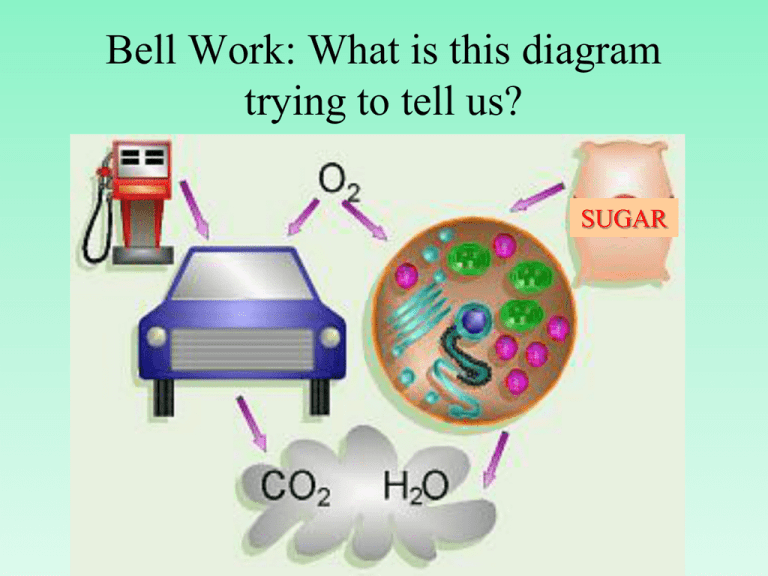Cellular Respiration 2014
advertisement

Bell Work: What is this diagram trying to tell us? SUGAR Cellular Respiration: (Or, How to turn Glucose into ATP) Oxygen + Glucose => ATP + Carbon Dioxide+ Water Review: What is ATP? • ATP stands for Adenosine TriPhosphate. •There is a large • It looks like this: amount of energy between the bonds of the last two phosphates….. A-P-P-P How Cells Generate ATP Cellular Respiration: The process of a Cell making ATP (energy) using oxygen and glucose. • Involves 3 steps: – Glycolysis – Kreb’s Cycle (Citric Acid Cycle) – Electron Transport Chain Step 1 Glycolysis • The first step of cellular respiration takes place in the Cytoplasm. • The process of breaking down glucose (6 C’s) into pyruvic acid (3 C’s) Spiral back review…. Facilitated Diffusion is how the glucose gets into your cells! • Glucose is helped across the membrane by transport proteins. • Doesn’t require energy Energy Carriers • Glucose contains lots of STORED energy. • When glucose gets broken down, high energy Hydrogen atoms (and their electrons) are carried from Glycolysis to the Kreb’s Cycle and Electron transport chain for later use. • These “energy carriers” are called “NADH” and “FADH2” Energy Carriers: NADH and FADH2 Energy Cost Glycolysis requires some energy to get started…..it costs the cell 2 ATPs to get started, but in the end 4 ATPs get made. This gives a net gain of 2 ATPs!!! Now what do we do with those Pyruvic Acids??? Recall: There are 3 main steps of Cellular Respiration, so what was step 2??? The Kreb’s Cycle! (Or Citric Acid Cycle) But before the Kreb’s Cycle… • There is a mini-step that takes the Pyruvic Acid and turns it into a compound called Acetyl Co-A. • This enters the “Powerhouse” of the Cell to kick off the Kreb’s Cycle. Mitochondria: label the matrix and cristae Cristae (Folded inner membrane) Matrix (liquid) Kreb’s Cycle • Happens inside the mitochondrial Matrix. • Turns twice to process each glucose molecule • Results in 2 more ATPs made!!! 1. Where is CO2 released? (Circle in the diagram) 2. How many ATP’s are released for 1 pyruvic acid? (count!) So…4 ATPs so far…where do the rest come in? Electron Transport Chain • Last stage of Aerobic Respiration • Takes place on the Cristae • High energy electrons go between proteins. Oxygen accepts the electrons at the end and combines with H+ to make water. 32-34 ATPs made per glucose in the ETC. Summary Picture But what if the cells run low on Oxygen??? Anaerobic Respiration Fermentation • When Cells don’t have enough oxygen for Cellular Respiration (anaerobic) • They do either Alcoholic or Lactic Acid as a byproduct • Only 2 ATPs are made…but that is better than none! Lactic Acid Fermentation Alcoholic Fermentation Dry Erase Review Facilitators: Please grab a white board for each student at your table. Appoint someone else to fetch a beaker of markers! 1. What is the name of the energy molecule of all cells? • ATP 2. What charge do the Posphate groups have on the ATP molecule? • Negative 3. List the 3 steps of cellular respiration. • Glycolysis, • Krebs Cycle • Electron Transport Chain 4. What is the organelle that converts glucose into ATP? • Mitochondria 5. What are the 2 parts to a mitochondria? • Cristae, Matrix 6. Which part of the mitochondria does the Kreb’s cycle occur? • Matrix 7. How many ATP are made in Glycolysis? • 4 total (but 2 are used up). 8. Which step of Cellular Respiration releases Carbon Dioxide? • Kreb’s Cycle 9. What essential gas is the final electron acceptor in the Electron Transport Chain? • Oxygen 10. What is the name of the anaerobic process that cells fall back on when oxygen runs low or is unavailable? • Fermentation 11. List the 2 types of Fermentation. • Lactic Acid and Alcoholic 12. Write the equation for Cellular Respiration. **How is this different than the photosynthesis equation? • Glucose + Oxygen ATP + Carbon Dioxide + Water • This is nearly flipped from photosynthesis! Individual Practice Complete the Cellular Respiration Overview worksheet. I will be coming around to check on your progress!



